German Veil Under a Thr fakers
Page 58
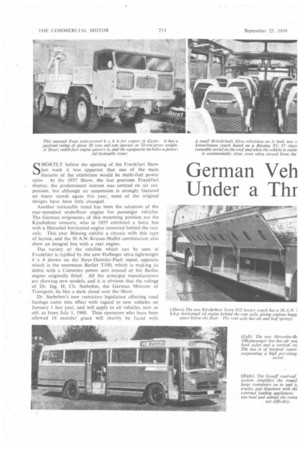
Page 59
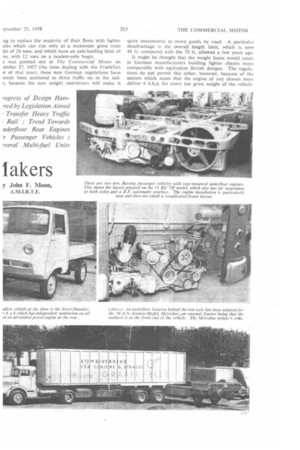
Page 60
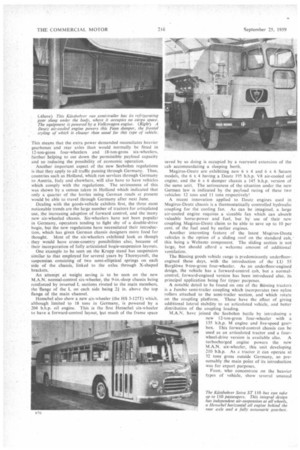
Page 61
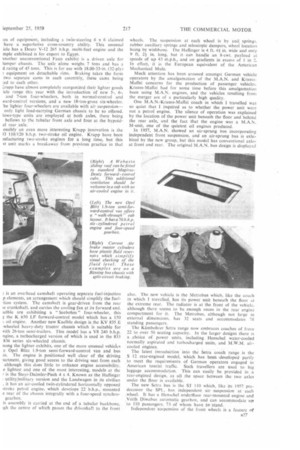
Page 62
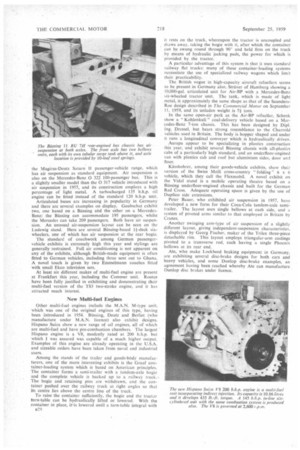
If you've noticed an error in this article please click here to report it so we can fix it.
y John F. Moon, A.M.I.R.T.E. SHORTLY before the opening of the Frankfurt Show last week it was apparent that one of the main , features of the exhibition would be multi-fuel power units. At the 1957 Show, the last previous Frankfurt display, the predominant interest was centred on air suspension, but although air suspension is strongly featured on many stands again this year, most of the original designs have been little changed.
Another noticeable trend has been the adoption of the rear-mounted underfloor engine for passenger vehicles. The German originators of this mounting position are the Kitssbohrer concern, who in 1955 exhibited a Setra bus with a Henschel horizontal engine mounted behind the rear axle. This year Bussing exhibit a chassis with this type of layout, and the M.A.N.-Krauss-Maffei combination also show an -integral bus with a rear engine.
The variety of the exhibits which can be 'seen at Frankfurt is typified by the new Haflinger ultra-lightweight 4 x 4 shown on the Steyr-Daimler-Puch stand, opposite which is the enormous Berliet T100, which is making its debut with a Cummins power unit instead of the BerIiet engine originally fitted. All the principal manufacturers are showing hew models, and it is obvious that the rulings of Dr. Rig. H. Ch. Seebohm, the German Minister of Transport, lie like a dark cloud over the Show.
Dr. Seebohrn's new restrictive legislation affecting road haulage came into effect with regard to new vehicles on January 1 last year, and will apply to all vehicles, new or old. as from July 1, 1960. Thus operators who have been allowed 18 months' grace will shortly be faced with ng to replace the majority of their fleets with lighter cies which can run only at a maximum gross train ht of 24 tons, and which have an axle-loading limit of ns, with 12 tons on a tandem-axle bogie.
s was pointed out in The Commercial Motor on ember 27, 1957 (the issue dealing with the Frankfurt .7v of that year), these new German regulations have ously been instituted to drive traffic on to the rails, because the new weight restrictions will make it
quite uneconomic to move goods by road. A particular disadvantage is the overall length limit, which is now 46 ft. compared with the 72 ft. allowed a few years ago.
It might be thought that the weight limits would result in German manufacturers building lighter chassis more comparable with equivalent British designs. The regulations do not permit this either, however, because of the section which states that the engine of any chassis must deliver 6 b.h.p. for every ton gross weight of the vehicle.
This means that the extra power demanded necessitates heavier gearboxes and rear axles than would normally be fitted in 12-ton-gross four-wheelers and 18-ton-gross six-wheelers, further helping to cut down the permissible payload capacity and so reducing the possibility of economic operation.
Another important aspect of the new Seebohm regulations is that they apply to all traffic passing through Germany. Thus, countries such as Holland, which run services through Germany to Austria, Italy and elsewhere, will also have to have vehicles which comply with the regulations. The seriousness of this was shown by a census taken in Holland which indicated that only a quarter of the lorries using German roads at present would be able to travel through Germany after next June.
Dealing with the goods-vehicle exhibits first, the three most noticeable trends are the large number of tractors for articlated use, the increasing adoption of forward control, and the many new six-wheeled chassis. Six-wheelers have not been popular in Germany, operators tending to fight shy of a double-drive bogie, but the new regulations have necessitated their introduction, which has given German chassis designers more food for thought. Most of the six-wheelers exhibited look as though they would have cross-country possibilities also; because of their incorporation of fully articulated bogie-suspension layouts.
One example to be seen on the Krupp stand has suspension similar to that employed for several years by Thornycroft, the suspension consisting of two semi-elliptical springs on each side of the chassis, linked to the axles through X-shaped brackets.
An attempt at weight saving is to be seen on the new M.A.N. normal-control six-wheeler, the 9-in.-deep chassis being reinforced by inverted L sections riveted to the main members, the flange of the L on each side being 2i in, above the top flange of the main channel.
Henschel also show a new six-wheeler (the HS 3-125T) which, although limited to 18 tons in Germany, is powered by a 204 b.h.p. oil engine. This is the first Henschel six-wheeler to have a forward-control layout, but much of the frame space
saved by so doing is occupied by a rearward extension of the cab accommodating a sleeping berth.
Magirus-Deutz are exhibiting new 6 x 4 and 6 x 6 Saturn models, the 6 x 4 having a Deutz 195 b.h.p. V8 air-cooled oil engine, and the 6 x 6 dumper chassis a 145 b,h.p. version of the same unit. The seriousness of the situation under the new German law is indicated by the payload rating of these two vehicles: 12 tons and 11 tons respectively!
A recent innovation applied to Deutz engines used in Magirus-Deutz chassis is a thermostatically controlled hydraulic coupling for the cooling fan. As can be imagined, a large air-cooled engine requires a sizeable fan which can absorb valuable horse-power and fuel, but by use of their new coupling Magirus-Deutz claim to be able to save up to 10 per cent, of the fuel used by earlier engines.
Another interesting feature of the latest Magirus-Deutz vehicles is the option of a sliding roof on the standard cab, ' this being a Webasto component. The sliding section is not large, but should afford a welcome amount of additional ventilation.
The Missing goods vehicle range is predominantly underfloorengined these days, with the introduction of the LU 55 Burglawe 9-ton-gross four-wheeler. As an underfloor-engined design, the vehicle has a forward-control cab, but a normalcontrol, forward-engined version has been introduced also, its principal application being for tipper purposes.
A notable detail to be found on one of the Bussing tractors is a Jumbo semi-trailer coupling which incorporates two nylon rollers attached to the semi-trailer section, and which rotate on the coupling platform. These have the effect of giving additional lateral stability to an articulated vehicle, and better distribution of the coupling loading.
M.A.N. have joined the Seebohm battle by introducing a new 12-ton-gross four-wheeler with a 135 b.h.p. M engine and five-speed gearbox. This forward-control chassis can be mot used as an articulated tractor and a four wheel-drive version is available also. A
turbocharged engine powers the new M.A.N. six-wheeler, this unit developing 210 b.h.p. As a tractor it can operate at 32 tons gross outside Germany, so presumably the main point of its introduction was for export purposes.
Faun, who concentrate on the heavier types of vehicle, show several unusual :es of equipment, including a twin-steering 6 x 6 claimed have a superlative cross-country ability. This unusual icle has a Deutz V-I2 265 b.h.p. multi-fuel engine and the rnple exhibited is for export to Egypt.
knother unconventional Faun exhibit is a driven axle for lumper chassis. The axle alone weighs 7 tons and has a d rating of 45 tons. This is for usc with 18.00-33-in. (32-ply) equipment on detachable rims. Braking takes the form two separate cams in each assembly, these cams being :ed to each other.
:rupp have almost completely reorganized their lighter goods icle range this year with the introduction of new 5-, 6-, and 7-ton four-wheelers, both in normal-control and orard-control versions, and a new 18-ton-gross six-wheeler. he lighter four-wheelers are available with air suspension— only light load-carrying German chassis to be so offered. lows-type units are employed at both axles, there being bellows to the tubular front axle and four at the hypoidel rear axle.
ossibly an even more interesting Krupp innovation is the {3 110/120 b.h.p. two-stroke oil engine. Krupp have been tufacturing two-stroke engines for a long time, but this st unit marks a breakaway from previous practice in that
: is an overhead camshaft operating separate fuel-injection p elements, an arrangement which should simplify the fuel:lion system. The camshaft is gear-driven from the rear ie crankshaft, and carries the cooling fan at its forward end. lelble are exhibiting a " Seebohm" four-wheeler, this g the K 650 LF forward-control model which has a 150 oil engine. Another new Kaelble design is the KV 835 E wheeled heavy-duty tractor chassis which is suitable for vith 26-ton semi-trailers. This model has a V8 240 b.h.p. ngine, a turbocharged version of which is used in the 833 836 series six-wheeled chassis.
nong the lighter exhibits, one of the more unusual vehicles e Opel Blitz 1.9-ton semi-forward-control van and bus ;is. The engine is positioned well clear of the driving iartment. giving good access to the driving seat from each although this does little to enhance engine accessibility.
e lightest and one of the most interesting, models al the is the Steyr-Daimler-Puch 4 x 4. Known as the Haflinger utility/military version and the Landwagen in its civilian , it has an air-cooled twin-cylindered horizontally opposed stroke petrol engine, which develops 22 b.h.p., mounted e rear of the chassis integrally with a four-speed synchrogearbox.
is assembly is carried at the end of a tubular backbone, igh the centre of which passes the driveshaft to the front
wheels. The suspension at each wheel is by coil. springs. rubber auxiliary springs and telescopic dampers, wheel location being by wishbone. The Haflinger is 4 ft. 41 in. wide and only 9 ft. 24in. long, but it can handle an 8-cwt. payload at speeds of up 43 M.p.h., and on gradients in excess of I in 2. In effect, it is the European equivalent of the American Mechanical Mule.
Much attention has been aroused amongst German vehicle operators by the amalgamation of the M.A.N. and KraussMaffei concerns for the production of passenger vehicles. Krauss-Maffei had for some time before this amalgamation been using M.A.N. engines, and the vehicles resulting from the merger are of a particularly high quality.
One M.A.N.-Krauss-Maffei coach in which I travelled was so quiet that I inquired as to whether the power unit were not a petrol engine. The silence of operation was explained by the location of the power unit beneath the floor and behind the rear axle, and the fact that the engine was a M.A.N. M-unit, one of the quietest oil engines produced.
In 1957, M.A.N. showed an air-sprung bus incorporating independent front suspension, and an air-sprung bus is exhibited by the new group, but this model has conventional axles at front and rear. The original M.A.N. bus design is displayed also. The new vehicle is the Metrobus which, like the coach in which I travelled, has its power unit beneath the floor at the extreme rear. The radiator is at the front of the vehicle, although there seems to be enough room in the rear engine compartment for it. The Metrobus, although not large in external dimensions, has 32 seats and accommodates 78 standing passengers.
The Kassbohrer Setra range now embraces coaches of from 22 to over 50 seating capacity. In the larger designs there is a _choice of power units, including . Henschel water-cooled normally aspirated and turbocharged units, and M.W.M. air • cooled engines.
The latest introduction into the Setra coach range is the .S 12 rear-engined model, whichhas b.een. -developedpartly to meet the requirements of German operators engaged in American tourist traffic. Such travellers are used to big luggage accommodation. This can easily be provided in. a rear-engined design, as all the space between the two axles under the floor is available.
The new Setra bus is the ST 110 which, like its-1957 predecessor the SPL, has independentair suspension at each .wheel. It has a Henschel underfloor rear-mounted. engine and .Voith Diwabus automatic gearbox, and Can accommodate up to 110 passengers, 73 Of whom have. to Stand.
Independent suspension of the front wheels is a feature of B77 the Magirus-Deutz Saturn II passenger-vehicle range, which has air suspension as standard equipment. Air suspension is also on the Mercedes-Benz 0 322 100-passenger bus. This is a slightly smaller model than the 0 317 vehicle introduced with air suspension in 1957, and its construction employs a high percentage of light metal. A turbocharged 135 b.h.p. oil engine can be fitted instead of the standard 120 b.h.p. unit.
Articulated buses are increasing in popularity in Germany and there are several examples on display. Gaubschat exhibit two, one based on a Bussing and the other on a MercedesBenz: the Bussing can accommodate 195 passengers, whilst the Mercedes can take 209 passengers. Both have air suspension. An unusual air-suspension layout can be seen on the Ludewig stand. Here are several BUssing-based 14-deck sixwheelers, one of which has air suspension at the rear bogie.
The standard of coachwork among German passengervehicle exhibits is extremely high this year and stylings are generally restrained. Full air conditioning is not apparent on any of the exhibits, although British-made equipment is often fitted to German vehicles, including three sent out to Ghana. A novel touch is given by two Emmelmann coaches fitted with small Ekco television sets.
At least six different makes of multi-fuel engine arc present at Frankfurt this year, including the Commer unit. Rootes have been fully justified in exhibiting and demonstrating their multi-fuel version of the TS3 two-stroke engine, and it has attracted much interest.
New Multi-fuel Engines
Other multi-fuel engines include the M.A.N. M-type unit, which was one of the original engines of this type, having been introduced in 1954. Bussing, Deutz and Berliet (who manufacture under M.A.N. licence) also exhibit designs. Hispano Suiza show a new range of oil engines, all of which are multi-fuel and have pre-combustion chambers. The largest Hispano engine is a V8, modestly rated at 200 b.h.p. but which I was assured was capable of a much higher output. Examples of this engine are already operating in the U.S.A. and sizeable orders have been taken from naval and industrial users.
Among the stands of the trailer and goods-body manufacturers, one of the more interesting exhibits is the Graaf container-loading system which is based on American principles. The container forms a semi-trailer with a tandem-axle bogie and the complete vehicle is backed up to a railway truck.. The bogie and retaining pins are withdrawn, and the container pushed over the railway truck at right angles so that its centre lies above the centre line of the truck.
To raise the container sufficiently, the bogie and the tractor turn-table can be hydraulically lifted or lowered. With the container in place, it'is lowered until a turn-table integral with
Et2.8 it rests on the truck, whereupon the tractor is uncoupled and draws away, taking the bogie with it, after which the container can be swung round through 90' and held firm on the truck by means of hydraulic jacking pads, the power for which is provided by the tractor.
A particular advantage of this system is that it uses standard railway flat trucks: many of these container-loading systems necessitate the use of specialized railway wagons which limit their practicability.
The British vogue in high-capacity aircraft refuellers seems to be present in Germany also, Striiver of Hamburg showing a 10,000-gal, articulated unit for Air-BP with a Mercedes-Benz six-wheeled tractor unit. The tank, which is made of light metal, is approximately the same shape as that of the SaundersRoe design described in The Commercial Motor on September II, 1959, and its unladen weight is 74 tons.
In the same open-air park as the Air-BP refueller, Schenk show a "Kohlenkuli" coal-delivery vehicle based on a Mercedes-Benz 7-ton chassis. This has been designed by Dipl. Ing. Dressel, but bears strong resemblance to the Charrold vehicles used in Britain. The body is hopper shaped and under it runs a longitudinal conveyer which is hydraulically driven.
Aurepa appear to be specializing in plastics construction this year, and exhibit several Missing chassis with all-plastics cabs of a particularly'high standard, and an underfloor-engined van with plastics cab and roof but aluminium sides, door and floor.
Kassbohrer, among their goods-vehicle exhibits, show their version of the Swiss Meili cross-country " folding " 6 x 6 vehicle, which they call the Flexmobil. A novel exhibit on the Vidal stand is a mobile operating theatre based on a Bussing underfloor-engined chassis and built for the German Red Cross. Adequate operating space is given by the use of Duplico side extensions.
Peter Bauer, who exhibited air suspension in 1957, have developed a new form for their Coca-Cola tandem-axle semitrailer. The layout uses single bellows at each side, and a system of pivoted arms similar to that employed in Britain by Cranes.
Another swinging arm-type of air suspension of a slightly different layout, giving independent-suspension characteristics, is displayed by Georg Fischer, maker of the Trilex three-piece detachable rim. This layout employs triangular-arm castings pivoted to a transverse rod, each having a single Phoenix bellows at its rear end.
Ate, who make Lockheed braking equipment in Germany, are exhibiting several disc-brake designs for both cars and heavy vehicles, and some Dunlop disc-brake examples, an agreement having been reached whereby Ate can manufacture Dunlop disc brakes under licence.




















































































































